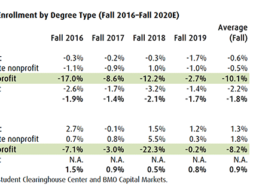
Bridging the Admissions-Marketing Divide
By Robert M. Keiser, M.B.A., Executive Director, Southeastern College/Southeastern Institute
It is common knowledge that for an institution’s population to grow, admissions and marketing strategies have to work in unison and not against each other. Likewise, it is also common knowledge that the creation of silos can breed mistrust, poor communication, and animosity. However, post-secondary institutions can easily fall into these known traps because collaboration is often harder than turning a blind eye to your colleague, empathizing with your colleague, or taking accountability for one’s performance and action.
When I assumed my role as Executive Director of Southeastern College/Southeastern Institute, I was surprised to find a clear gap between the operations and vision of admissions and marketing.
In fact, the departments’ interaction was limited to a seven-minute call once a month, which only bred more animosity and eventually apathy. I was perplexed both departments retained competent people who desired a better relationship with their counterparts. Eventually, I realized that the divide between admissions and marketing occurred over time because the relationship was left untended and, when allowed, departments have a tendency to segment naturally. Each department has a set of underlying grievances that when left unaddressed can breed a negative environment.
Admissions grievances related to marketing:
- Marketing is delivering bad inquiries
- Marketing does not understand our market (multi-location system)
- Marketing has no initiative to test new marketing opportunities
- Marketing is clueless about branding – lack of school visibility in the local market
- Marketing does not understand student demographics
Marketing grievances related to admissions:
- Admissions is disingenuous about inquiry quality
- Admissions would be better if they had less turnover
- Admissions is poorly trained due to the amount of turnover they experience
- Admissions does not work inquiries as they should
- Admissions think they know marketing, they don’t, and if they just did their job the whole institution would be more effective
Divergent perspectives
The root causes of these departmental grievances were related to three overarching sources of misalignment: geography, time-span of work, and organizational hierarchy/management. First, geography played a large role in our divide as Southeastern is located in three states and five different cities. When admissions viewed their locations, they saw home, students with aspirations and challenges, friends and colleagues, companies to collaborate with, competitors, and community. Marketing saw populations, DMAs, ZIP codes, branding opportunities, demographics, impressions, etc. Second, time-span of work also played a pivotal role in the misunderstanding. Admissions in our system is typically thinking about and operating in a one to four-month period. Admissions coordinators are thinking about their monthly start, their progress towards a future start, or their quarterly performance. On the other hand, marketing typically works with a three to fifteen-month time frame in mind because they must plan for future advertising opportunities. Third, the organizational chart and the executive managing the two departments plays a driving role in how the two departments interact. Some organizations treat the departments as one entity, while some treat the departments as two separate entities that should collaborate, while others treat the departments as separate entities that should not intermingle.
Essentially, culture is driven by organizational leaders and by the everyday unconscious and conscious rituals and practices utilized by the employees of the campuses. Thus, culture is not only driven by leadership but also by employees’ conscious or unconscious actions every day.
Therefore, it is pivotal to any strategy focused on collaboration that the executive openly and aggressively promotes collaboration, open discourse, and provides a forum for the departments to operate and talk with full psychological safety and transparency.
Additionally, the executive must hold the employees accountable for collaboration and openly praise evidence of collaboration across departments. This promotion of a collaborative culture will help transform the way the employees work together and on their daily business. Ultimately, admissions and marketing view phenomena differently, as they should and as they are paid to do, but awareness of this natural divergence and a focus on mutual goals can bridge the gap between the perspectives. Management, or the executive, can play a leading role in transforming the culture into a collaborative one by clearly articulate each department’s goals, role descriptions, and accountabilities, communicating a common vision and goal, encouraging open dialogue and feedback loops, and publicly praising collaboration across departments when the opportunity presents itself.
Culture change and eventually solidification is a never-ending process and it has been a two-year long road thus far for Southeastern. By creating opportunities for stakeholders to vocalize their opinion and impressing upon these stakeholders the need for collaboration and transparent dialogue change was realized gradually. Management must be committed to this change and embrace the constructive friction associated with encouraging dialogue when previous precedent was to suppress opinion and to stay within one’s lane.
Danger of misalignment
The danger of misalignment between admissions and marketing departments cannot be overstated. Misalignment breeds poor morale, which can result in poor student service and a toxic work environment where high achievers depart for greener pastures and disenchanted staff fail to apply themselves. Additionally, misalignment can often breed poor outcomes, which can give birth to rogue mentalities. When teams are failing and goals are not achieved staff often feel the need to take charge. Staff members with initiative may try to act “outside of the box” to change their fortunes. Often divergent thinking can be good, but in a heightened regulatory environment, marketing and admissions must be careful to not push the envelope too much for fear of non-compliance and regulatory backlash. Finally, the most obvious danger of misalignment between admissions and marketing is a decline in enrollment and population. This situation is best characterized by both departments rowing vigorously, but in opposing directions, causing more animosity between the departments.
Benefit of alignment
There are clear benefits to alignment but also unforeseen and unplanned for benefits. The expected benefit was a reversal in fortune and growth in enrollment and population. Southeastern experienced this fortuitous change, as the institution grew by 9.64 percent YOY in 2017 and is growing by over 7 percent YOY in 2018. These two years of growth are a far departure from the most recent past which resulted in Southeastern teaching out a couple of its campuses due to declining enrollment and financial stability.
Creating a more collaborative environment between admissions and marketing was intended to help improve enrollment and grow the population, but the unintended consequence of alignment may be the most beneficial long-term.
The unforeseen benefit was the creation of a design thinking process that has stimulated innovation in a previous stagnant system.
Design Thinking 101
- Empathize – Admissions and marketing developed a common understanding
- Define – Admissions and Marketing were able to combine their experiences and describe the challenges that they faced together
- Ideate – Due to the open collaboration, brainstorming, and feedback loops admissions and marketing are able to generate a range of crazy, creative ideas
- Prototype – Once admissions and marketing brainstormed they were able to synthesize their ideas into a workable initiative
- Test – These workable initiatives were beta tested, typically at one campus, to provide feedback to admissions and marketing related to efficacy
- Implement – Once the ideas are beta tested, the initiatives are rolled out to all five campuses, and the vision is put into effect
Although not intended, the alignment of Southeastern’s admissions and marketing teams birthed a design thinking process. A process that is characterized by empathy, collaboration, mutual brainstorming, shared accountabilities, and joint success. This new process of innovation continues to pay dividends for Southeastern as we churn out new ideas championed by both departments. In sum, collaboration and the breaking down of silos is not a novel idea, but I have too often seen leaders ignore the need to align departments because of the ease of not doing so. The goal for Southeastern was clear – bring the departments together to right the ship and to grow again. Although, we have reached that goal it has become evident that the goal was a small step in the right direction and the journey has proven to be even more fruitful than the intended goal. It is through trial and error and a breaking down of preconceived notions that Southeastern has stumbled upon its most important development in its admissions marketing journey – the unconscious creation of a platform for collaborative innovation.
ROBERT KEISER, raised in Fort Lauderdale, Florida, has lived in Washington D.C. and Barcelona, Spain but now resides full-time in Delray Beach, Florida. Robert holds a Bachelor’s of Science as well as a Master of Business Administration (MBA) from The George Washington University in Washington D.C. Robert is also currently pursuing a PhD in Higher Education Leadership from Capella University.
Robert Keiser currently serves as the Executive Director of Southeastern College and Southeastern Institute and was previously the Campus President of Southeastern College’s West Palm Beach Campus. Robert Keiser previously worked at Keiser University’s Fort Lauderdale, West Palm Beach, and Port St. Lucie campus. During his experience with Keiser and Southeastern, Robert has worked in admissions, financial aid, academics, and governmental relations. Prior to his time in Higher Education, he worked for U.B.S Financial Services in wealth management and Skanska USA, construction management, in business development. He also served as an appointee to Florida Governor Crist’s Governor’s Council on Physical Fitness. In this capacity, he contributed to a state action plan to combat childhood obesity and testified before U.S. Congress on behalf of the FIT Kids Act; an act mandating 1 hour of physical education in America’s public schools.
Contact Information: Robert M. Keiser, M.B.A. // Executive Director // Southeastern College/Southeastern Institute // 954-261-5135 // rkeiser@sec.edu // www.sec.edu; http://www.southeasterninstitute.edu











